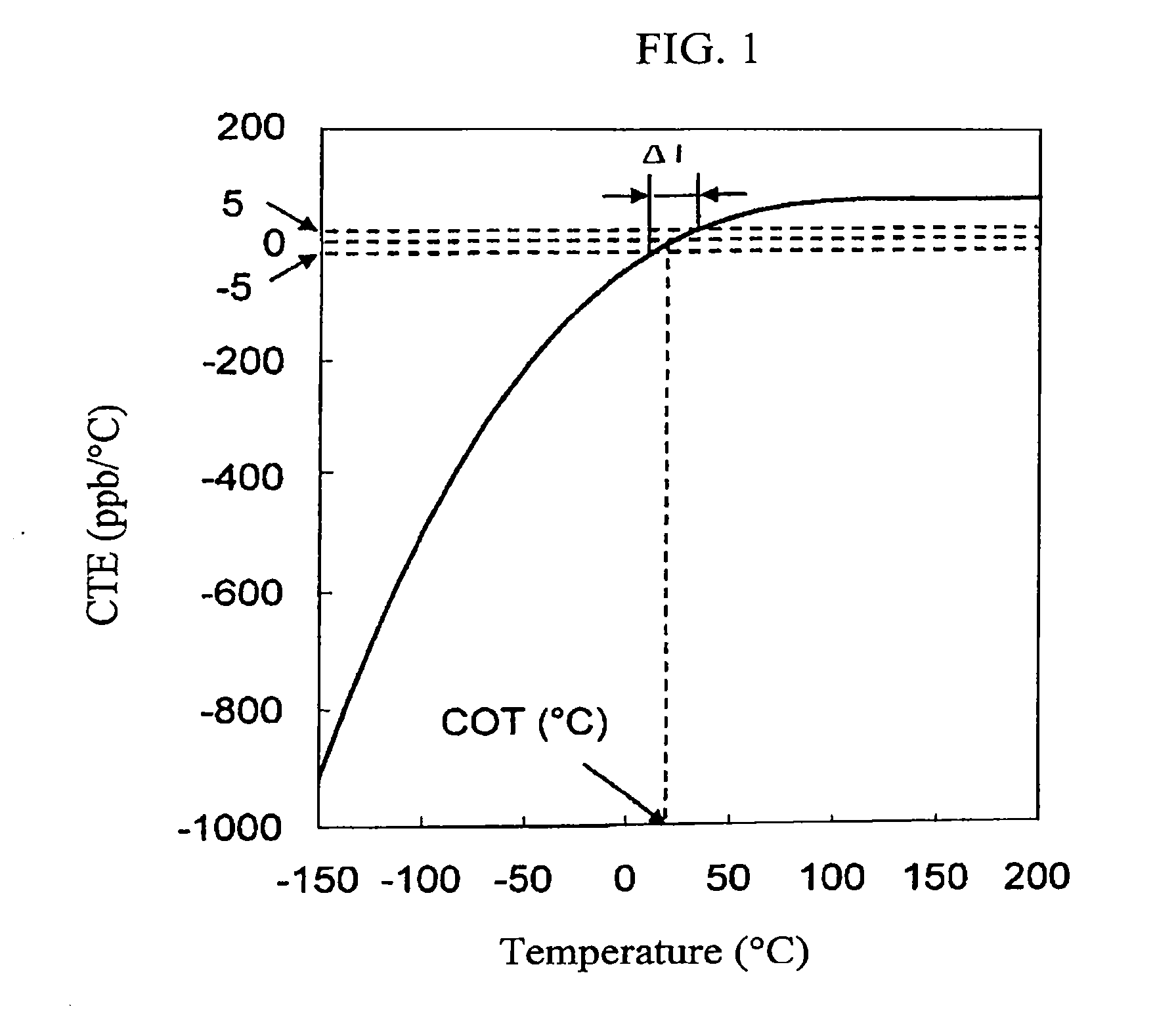Method for producing tio2-sio2 glass body, method for heat-treating tio2-sio2 glass body, tio2-sio2 glass body, and optical base for euvl
a technology of glass body and heat treatment method, which is applied in the direction of photomechanical treatment originals, manufacturing tools, instruments, etc., can solve the problems of large modifications, inability to use refractive optical systems, and large striae of glass bodies, so as to reduce the stress caused by striae and reduce the effect of productivity
- Summary
- Abstract
- Description
- Claims
- Application Information
AI Technical Summary
Benefits of technology
Problems solved by technology
Method used
Image
Examples
example 1
[0170]TiO2—SiO2 glass fine particles obtained by gasifying TiCl4 and SiCl4 each serving as a glass forming material of a TiO2—SiO2 glass, respectively, mixing those and subjecting to heat hydrolysis (flame hydrolysis) in oxyhydrogen flame were deposited and grown on a substrate to form a porous TiO2—SiO2 glass body. Here, both a static mixer and a filter were provided as stirring mechanism for raw material gasses short of feeding TiCl4 and SiCl4 to a burner (step (a)).
[0171]Since it is hard to handle the porous TiO2—SiO2 glass body obtained without any treatment, the porous TiO2—SiO2 glass body was held in the air at 1,200° C. for 4 hours in the state still deposited on the substrate, and then separated from the substrate.
[0172]Thereafter, the porous TiO2—SiO2 glass body was held at 1,450° C. for 4 hours under reduced pressure, to thereby obtain a TiO2—SiO2 dense body (step (b)).
[0173]The TiO2—SiO2 dense body obtained was placed in a carbon mold, and held at 1,680° C. for 4 hours, t...
example 2
[0176]A molded TiO2—SiO2 body was obtained by carrying out the same procedures as in Example 1, except that, after completion of the step (d-2) in Example 1, as the step (e), the glass body was held at 1,700° C. for 4 hours and then naturally cooled (average temperature decreasing rate: about 160° C. / hr) to room temperature in an electric furnace, and the step (f) was not conducted.
example 3
[0177]The molded TiO2—SiO2 body obtained in Example 2 was heated to 1,590° C. in an electric furnace, held at the temperature for 120 hours, cooled to 950° C. at a rate of 10° C. / hr, held at 950° C. for 72 hours, cooled to 900° C. at a rate of 5° C. / hr, held at 900° C. for 72 hours, and then cooled to room temperature, thereby obtaining a molded TiO2—SiO2 body.
[0178]In the above heat treatment, the time that the TiO2—SiO2 body was held in the temperature region of from T1−90 (° C.) to T1−220 (° C.) was 160 hours, and the average temperature decreasing rate in cooling the TiO2—SiO2 body up to T1−220 (° C.) from T1−90 (° C.) was 0.8° C. / hr.
PUM
| Property | Measurement | Unit |
|---|---|---|
| wavelength | aaaaa | aaaaa |
| width | aaaaa | aaaaa |
| wavelength | aaaaa | aaaaa |
Abstract
Description
Claims
Application Information
 Login to View More
Login to View More - R&D
- Intellectual Property
- Life Sciences
- Materials
- Tech Scout
- Unparalleled Data Quality
- Higher Quality Content
- 60% Fewer Hallucinations
Browse by: Latest US Patents, China's latest patents, Technical Efficacy Thesaurus, Application Domain, Technology Topic, Popular Technical Reports.
© 2025 PatSnap. All rights reserved.Legal|Privacy policy|Modern Slavery Act Transparency Statement|Sitemap|About US| Contact US: help@patsnap.com

